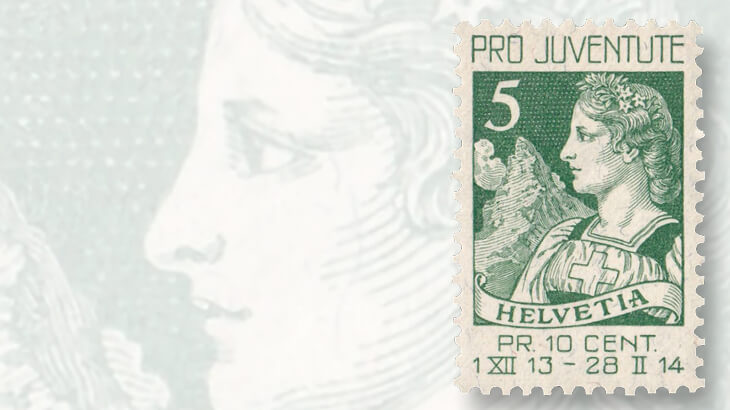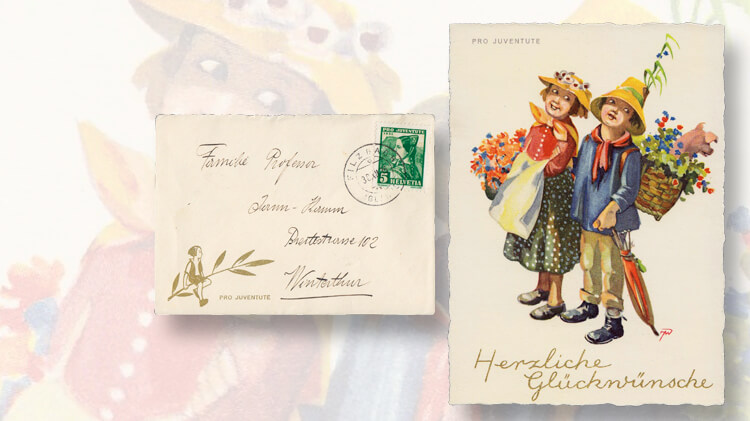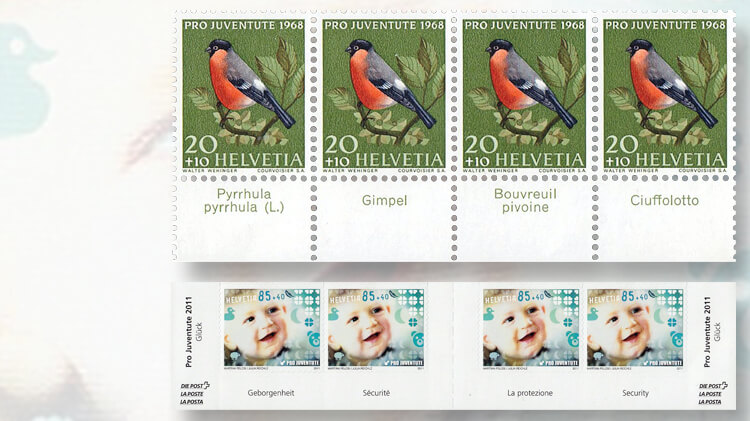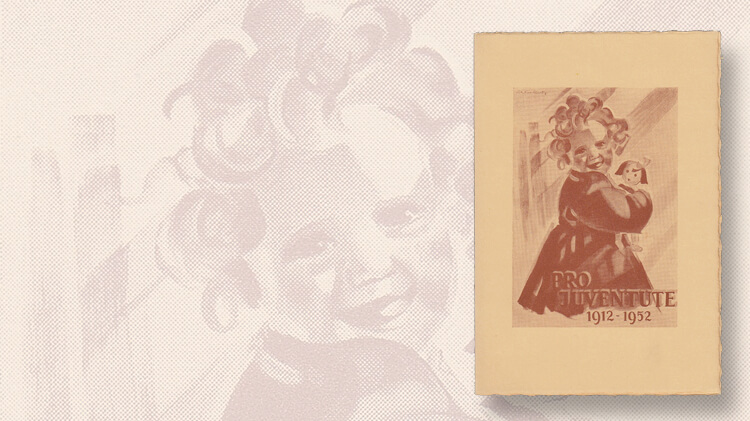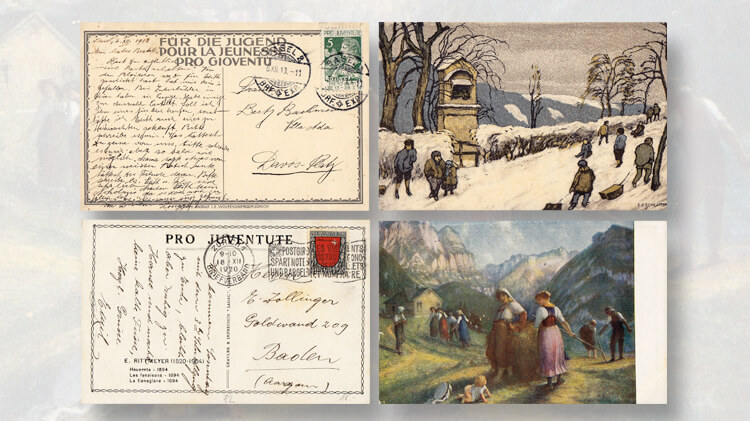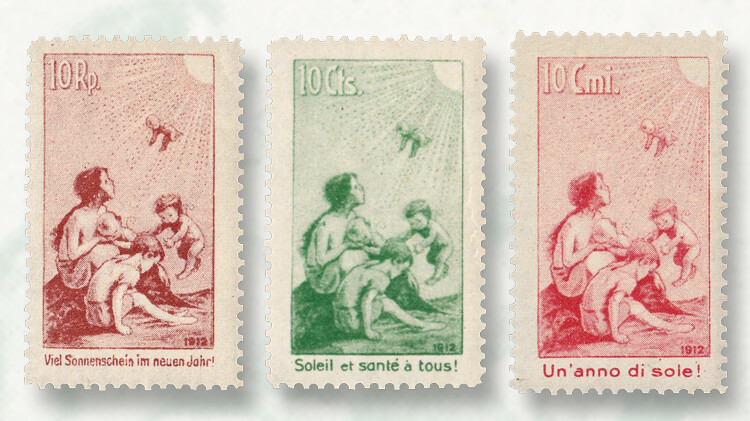World Stamps
What makes Swiss Pro Juventute stamps so special?
By Richard T. Hall
As the first in a continuing series on the stamps of Switzerland, let me begin by telling what first attracted me to its stamps — the Pro Juventute issues, in particular the issues from 1943 to 1976 that show flora and fauna. Six examples of these issues are shown nearby.
The stamps were printed by Courvoisier S.A. of La Chaux-de-Fonds in Canton Neuchatel in western Switzerland. Courvoisier perfected multicolor photogravure printing and began printing stamps for the Swiss postal service in 1931.
What attracted me to these stamps was the intricate detail and simple designs coupled with quality printing.
Connect with Linn’s Stamp News:
Sign up for our newsletter
Like us on Facebook
Follow us on Twitter
You have to agree that for early photogravure printing before the advent of computer-controlled presses, the Swiss Pro Juventute stamps are right up there at the top in quality.
Having succumbed to these stamps, the next step for any stamp collector is to try to fill the spaces in the album. This meant going back to the first of the Pro Juventute stamps of 1912. But first, just what does Pro Juventute mean and what does it do?
The words Pro Juventute are Latin for “For the Children.” Like the country name on Swiss stamps, Helvetia, the neutral language in a multilingual country was Latin; hence you will find Pro Patria, “For the Country,” and Pro Infirmis, “For the Infirm,” on Swiss stamps.
The Pro Juventute Foundation was formed in 1912 as an advocate for children’s needs and rights from some 3,000 local and specialized child welfare organizations that existed in Switzerland at that time.
Taking a clue from other postal administrations that had issued semipostal stamps for charities, the Pro Juventute Foundation asked permission of the Swiss postal administration in 1912 to issue charity stamps during the holiday season to benefit the foundation, hoping that people would use the stamps on their greeting cards.
Unfortunately, the request came too late for the postal administration to issue the stamps, so the foundation had three labels (one in each of the three principal languages spoken in Switzerland) printed and sold for 10 centimes both at post offices as well as privately.
Because the labels had no franking value, they are not listed in the Scott Standard Postage Stamp Catalogue. However, the Swiss catalogs do list them. The three labels are shown nearby.
The first Pro Juventute stamp with franking value was issued in 1913. You will see at the bottom of the stamp “PR. 10 CENT” and “1 XII 13 - 28 II 14.” This states that the price of the stamp is 10c, 5c for postage and 5c to the foundation, and that the stamp is only valid between Dec. 1, 1913 and Feb. 28, 1914. This limited period of validity was common for most Swiss semipostals and commemoratives up until 1960.
No Pro Juventute stamp was issued in 1914, but for every year since, Pro Juventute stamps have been issued just prior to the holiday season.
What makes these stamps interesting is that they have tended to run in series of similar designs. The 1915-17 stamps show children in folk costumes; 1918-26, cantonal coats of arms; 1933-42, women in traditional cantonal dress; 1943-49, flowers; 1950-57, insects; 1958-64, flowers; 1965-67, animals; 1968-71, birds; 1973-76, forest plants; 1978-81, municipal coats of arms; 1983-86, children’s toys and fairy tales; 1987-90, child development; 1991-94, forest flora; 1995-98, animals again; 1999-2001, children’s books; 2002-05, children’s rights; and 2006-08, children’s art.
Later years’ issues have not been continuing series.
So now you’re hooked on collecting Pro Juventutes. None of them is particularly pricey or hard to find, the only exception being the Italian forerunner that has a catalog value in the Swiss Zumstein catalog of around $1,200 in mint condition. So where do you go from here?
There are many paths open to you, including first-day covers (which can be very expensive for the earlier issues); postal usages, particularly to foreign addresses prior to 1921 when they became valid for all foreign mail (prior to that the rules varied by country); marginal tabs; and printing varieties.
 The story of Switzerland’s World War II Peace commemoratives: The set seems well suited to this time of year when so many of us give thanks and pause to consider the value of human harmony and cooperation.
The story of Switzerland’s World War II Peace commemoratives: The set seems well suited to this time of year when so many of us give thanks and pause to consider the value of human harmony and cooperation.
Printing varieties should interest you if you’re a fly-specker. The photogravure process lent itself to the creation of small flaws and retouches on the printed stamps from the way the individual stamps were produced on the printing plate. This is a subject for an article on its own, but suffice to say it is an area that you can get lost in.
Marginal tabs is an easy sideline to get into. Various Pro Juventute issues, beginning in 1943, had descriptive marginal tabs in Latin, German, French, and Italian such as those shown nearby. More recent issues have replaced Latin with English, also shown nearby.
If you would like to venture further afield you might like the Pro Juventute postcards that were issued annually from 1912 to 1960, again for use as holiday mailings. The cards showed works of Swiss artists, ranging from classic paintings to kitchy designs. None are expensive but can be hard to find, especially if franked with the Pro Juventute stamp of that year. Two of these cards are shown nearby.
Another interesting sideline are the Briefli or “Little Letters.” These were first issued in 1926 and up until 1960 had interesting small illustrations or borders. After 1960, the envelopes simply were inscribed “Pro Juventute.”
Except for the Briefli with Italian inscriptions, these are not expensive but can be hard to find.
The exception is the four year period, 1956-1959, in which Briefli with Romansch inscriptions were issued. As might be expected, these are quite rare.
What are hard to find are the greeting cards that were sold with the envelopes. These were issued in German but also in French and Italian in some years.
If you want to venture even further afield, the Pro Juventute Foundation presented thank you cards to volunteers that have a cover design based on one of the Pro Juventute stamps of that year and a set of the stamps inside. These make a nice addition to an album page.
So our album page now can include for a particular year the following: the stamps themselves, a first-day cover, a foreign cover (prior to 1921), printing flaws, marginal tabs, Pro Juventute postcards, Briefli and the associated greeting cards, and the foundation thank you cards.
If you want a challenge, try to find all these items. Even for just one year, you will be hunting far and wide to complete the items. But that is what stamp collecting is about — the thrill of the chase. Talley ho!
For further information on the Pro Juventute issues, the Scott Standard catalog provides a starting point, but one of the Swiss catalogs — Zumstein or SBK (Schweizer Briefmarkenkatalog) will provide much more detail, as will the Zumstein Spezialkatalog Schweiz, the Swiss equivalent of the Scott Specialized Catalogue of United States Stamps and Covers.
The Pro Juventute postcards are cataloged in Hubert Schad’s Pro Juventute Bild-Postkarten 1912-1960, and the Pro Juventute Briefli in his Pro Juventute Briefli 1926-1960.
All these references are available from the American Philatelic Research Library to members of the American Philatelic Society or one of its affiliated societies.
The American Helvetia Philatelic Society is an affiliate of the APS. Membership is $23 per year and brings you its award-winning journal Tell six times a year and access to its sales circuits. For more information, contact the society's secretary or visit the society’s website.
MORE RELATED ARTICLES
Headlines
-
US Stamps
Oct 7, 2024, 3 PMMcMurtrie dismissed as APS education director following Sept. 21 arrest
-
US Stamps
Oct 7, 2024, 12 PMVasiliauskas named president of Mystic Stamp Co.
-
US Stamps
Oct 6, 2024, 5 PMApgar souvenir card available
-
US Stamps
Oct 6, 2024, 4 PMFirst Continental Congress and U.N. stamps receive Scott catalog numbers

